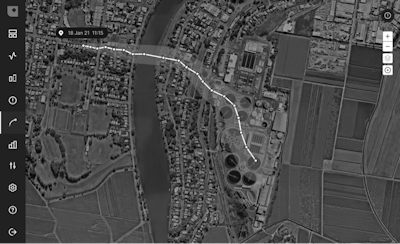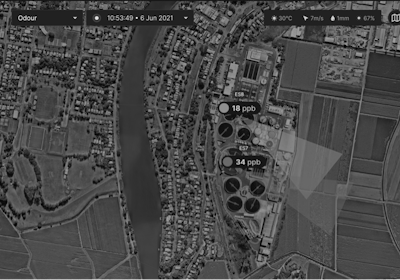In today’s world, perception has become reality.
Maintaining trust and a positive reputation in the community while balancing output is far from easy for wastewater management operators.
Wastewater operators are under pressure to ensure that their plant is operating efficiently and effectively, which not only helps their operations go ahead smoothly but also plays an important role in protecting community relationships.
However, managing community expectations is never a simple and straightforward task when odour or air quality complaints are directed at operations. Measuring these pollutants is highly complex and has always involved time-consuming and laborious processes to draw valuable insights from the data.
Wastewater treatment plants use a wide variety of pollutants and chemicals, and the treatment process itself can produce emissions such as hydrogen sulphide and ammonia. Additionally, the nature of the process means that the emissions are often highly concentrated, making them difficult to control.
Overall, managing odour and air quality emissions at wastewater treatment plants is a complex task that requires careful planning and ongoing odour monitoring to ensure that the facility is operating in compliance with regulations and is not having a negative impact on the surrounding community.
The jury is out: Community issues around odour are still an ongoing challenge for wastewater management operators
For many years, buffer distances around wastewater management plants were an effective option for operators working to minimise the impact of operations in local communities. But now, towns and cities are quickly expanding into these areas.
As challenges like these have emerged, wastewater management operators have had to become increasingly advanced with their approach to keeping odour and air quality within acceptable thresholds to protect their social licence to operate and uphold a positive reputation in the community.
At a recent Envirosuite webinar, attendees were asked whether they had experienced issues with nearby communities. Those in attendance were from various industries and included operators from wastewater facilities.
Results indicated that managing these relationships is still an ongoing challenge for many operations; with 50% of attendees saying they had experienced issues with their surrounding communities.
Public perception can have a tangible impact at your site. Environmental incidents of any size can lead to scrutiny and interruptions, hindering operational success.
Protecting your operation’s reputation and building trust with the community is not just important – in today’s landscape it has become mission critical.
How does environmental management software help protect reputation of wastewater management sites?
Protecting the reputation of your wastewater management facility has become easier than ever before, thanks to significant advancements in environmental management software.
While not all environmental management software can go beyond data collection and storage, solutions such as Envirosuite’s EVS Omnis platform have made it possible to collect and interpret complex data, address operational challenges and build trust with stakeholders – all without the burden of overly complex, time-consuming and laborious tasks for employees.
Environmental management software that harnesses environmental intelligence (EI) is a particularly powerful tool for wastewater operators. EI ushers in new methods of decision support at wastewater treatment plants. Equipped with real-time data and advanced insights based on local weather and IoT data that’s collected at deployed environmental monitoring networks across the facilities, operational decisions are informed and backed by highly accurate data.
As an operator, these actionable insights from EI are the key to protecting your wastewater management site’s reputation.

EVS Omnis software provides wastewater operators with a bird’s eye view of site-generated emissions at their plant operations
1. Demonstrate that you take environmental issues seriously
Wastewater management facilities provide a necessary service that is critical for communities to function. As populations continue to grow, so does the need for wastewater facilities.
It’s understandable that community members don’t want to be exposed to potent smells, poor air quality and the like while going about their day-to-day lives. The onus is now on operators to find an acceptable balance between the site’s operational needs, and the needs and expectations of the community to ensure they can seamlessly co-exist.
With environmental management software at their fingertips, operators can make more informed decisions about when and how to adjust treatment processes or employ mitigation strategies, such as activating odour control systems or adjusting the timing of operations.
Additionally, this information can be used to engage with the community and provide transparent communication about the facility's odour management efforts. This will help make it clear to those in surrounding areas that minimising the impacts – one that you’re willing to invest in – and that steps are being taken to make finding an effective solution as fast as possible a priority.
Reducing response times with targeted action doesn’t just help keep community relationships intact; it also leads to fewer costly hold-ups for operators.
2. Improve the complaint resolution process
Public expectations for how odour issues are managed are on the rise. Today there’s little room for wastewater management operators to slip up with keeping these types of issues under control without it being written about in the press, or on appearing on a community social media page.
When an incident does occur, community complaints are often quick to follow. This can be incredibly disruptive to operations, even when only a handful of complaints are submitted as they must allocate time and resources to each one.
Across many industries, managing complaints for problems involving air quality, odour and similar is notoriously difficult. Weather can change seemingly without warning and the problem is usually invisible and difficult to trace.
Resolving complaints is no easy task for operational teams, who are responsible for accurately and quickly pinpointing the source of the issue. Though this is only the first step. Even once teams have identified the cause, they need to be able to find a suitable solution that can be implemented swiftly and effectively.
Most environmental monitoring systems only provide a static reading without context to the source of the issue. However, the EVS Omnis platform uses emissions modelling and predictive weather forecasting to paint a holistic, easy-to-understand picture of your facility both today, and tomorrow.
With EVS Omnis, if a complaint is made lengthy investigations and inconclusive results can be avoided altogether. There is no ambiguity or uncertainty – you can respond without hesitation using highly accurate insights on the source of the issue.
In addition, wastewater management facilities utilising EVS Omnis can also easily be used to demonstrate to communities the source of complaints (either caused by the facility or not) with easily understood information. By inviting communities to become a part of the conversation, operators demonstrate a clear willingness to work with individuals by actively seeking out their opinions and input and taking them on board.
Through this collaboration wastewater management operations can build greater trust with the community and as a result of this improve the reputation of the site. This can have flow-on benefits for the facility, which is less likely to receive formal complaints from regulators.

Reverse trajectory modelling is a powerful technique that wastewater operators can use to determine and responsibility and show the community the source of their odour complaints
3. Establish greater transparency with local communities
When wastewater management operations make data publicly available to the community, this transparency can have a strong impact on how community members perceive the operation and what they are doing on a routine basis.
When operators tell community members that they are doing everything they can to manage risks and minimise impacts but don’t provide any data that is easily understood by non-experts, building trust can be difficult. The community may be concerned that the operation is withholding certain information or providing it in a misleading way to paint the facility in a more positive light, especially if their experience doesn’t align with what is being communicated to them.
However, when people can see, understand and draw conclusions from the data and insights for themselves there is greater clarity around what exactly is occurring.
EI is changing the way this useful information is displayed so that communities can be educated on these complex issues even as non-subject experts.
If an issue does arise, facilities can also confidently refute or accept responsibility and transparently communicate this with communities. With defensible data, they can back up what they’re saying.
By establishing greater transparency in these ways, wastewater operations build social licence to operate and greater tolerance in their neighbourhoods.
4. Avoid chronic problems altogether by planning ahead
To manage odour and air quality emissions, treatment plants often employ a combination of methods, including chemical scrubbers, biofilters, and activated carbon filters. However, these methods can be costly and require regular maintenance to ensure they are functioning properly. Additionally, the effectiveness of these methods can vary depending on the specific pollutants present and the conditions of the treatment process.
A sure way to damage an operation’s reputation in the community is by planning ahead for periods of high risk with highly accurate insights.
However, it’s difficult for operational teams to plan for changes in weather that lead when presented with too many options or fragmented data. Failure to respond rapidly to unplanned changes in the weather and potential emission events can quickly lead to negative and costly consequences.
If community members are exposed to issues for prolonged periods of time, such as potent odours or poor water quality, this can understandably cause frustration. When they have lodged a complaint – or even numerous complaints as the issue has persisted – this only makes matters worse.
Environmental management software with EI capabilities keeps your team aware of what’s next. Actionable insights let you improve efficiencies, reduce the impact of unplanned emissions events and plan with confidence.
City of Kalamazoo Water Reclamation Plant (KWRP): Building community relationships and managing risk proactively
Located in southwestern Michigan, the City of Kalamazoo is home to more than 190,000 residents. The City of Kalamazoo Water Reclamation Plant (KWRP) provides treatment services to 18 Kalamazoo-area municipal jurisdictions.
Most of the wastewater comes from industrial sources such as manufacturers of pharmaceuticals and organic materials. Projects involving groundwater clean-up and remediation of contaminated groundwater also utilise its treatment services.
Over time, KWRP has received numerous complaints from the local community due to odour incidents. However, the plant has had difficulty determining whether these issues originate from their operations.
Working with Envirosuite, KWRP implemented a comprehensive platform for proactively and accurately measuring and managing odour risks. EVS Omnis provided greater situational awareness, which made it possible for KWRP to:
Monitor and visualise H2S data in real-time;
Receive alerts of threshold breaches to identify odour issues sooner;
Pinpoint the source of community odour complaints quickly and easily with reverse trajectory modelling;
Identify problematic areas of the plant as air quality emission events unfold;
Schedule work on-site during low-risk periods with predictive odour modelling;
Support operational decisions with real-time local weather forecasts and predictive odour modelling.
Avoid impacting the community you serve with EVS Omnis for proactive odour management
Odour issues can overwhelm staff at wastewater treatment plants and are incredibly difficult to investigate and manage.
EVS Omnis provides situational awareness to operators at wastewater management operations to act quickly and plan for rapid changes in weather.
Whether you receive a complaint, need to schedule maintenance or have made it a priority to proactively mitigate environmental risks, EVS Omnis provides the information you need to keep operations moving along smoothly.
With EVS Omnis, wastewater management operations can:
Use real-time environmental performance data to act on site-generated emissions and limit breaches and stoppages;
Stay ahead of emissions impact by using predictive insights from air quality dispersion modelling to plan operations with confidence;
Engage with stakeholders and respond to complaints using defensible data that can be accessed by the community for greater transparency.
Get in touch with one of our experts at Envirosuite to learn more about the right solution for your wastewater treatment plant today.
